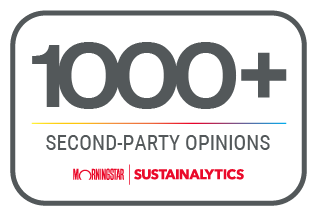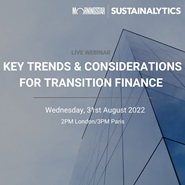Growth of sustainable finance has opened the door for companies in carbon intensive industries to contribute to the reduction of greenhouse gas emissions. Forward-looking organizations in these sectors once left out of environmental finance programs now have the opportunity to to raise capital through the issuance of transition or “brown” bonds.
Learn more about our Transition Bond service.

Find out how the path of green finance has evolved, as well as our view on where the sustainable finance bond market is headed.
Latest Insights
How an International Airline Took Transition Bonds to New Heights
The Mining Industry: Challenges and Opportunities of Decarbonization
Key Trends & Considerations for Transition Finance
Overview of Our Transition Bond Service
Grounded in international science-based targets – Sustainalytics’ methodology for assessing transition bond frameworks includes both issuance-level considerations and issuer-level considerations. For this, Sustainalytics developed detailed criteria for transition-eligible activities.
Issuance-level Considerations
Use of proceeds: Alignment of financed business activities and projects with Sustainalytics' transition eligibility criteria
Project evaluation and selection
Management of proceeds
Allocation and impact reporting
Issuer-level Considerations
Issuer’s climate transition strategy and governance
Business model environmental materiality
Climate transition strategy to be ‘science-based’ including targets and pathways
Implementation transparency
Key Benefits for Issuers of Transition Bonds
Investor diversification for sectors that have been traditionally excluded from the green market but have a key role to play in addressing climate change.
Enhance visibility of your bond, company and sustainability activities.
Reinforce your sustainability strategy through commitments to investors and key stakeholders.
Increase investor dialogue and engagement that facilitates a better understanding of your business.
Use of Proceeds Assessment Service
At Sustainalytics we also offer a Use of Proceeds (UoP) Assessment. The assessment is an evaluation of the eligibility criteria for categories of sustainable projects that issuers intend to finance through sustainable finance instruments, such as green, social, sustainability and transition bonds or loans.
Non-public Assessment
The final report is a non-public assessment that can be used by the issuer teams for internal purposes only eg. to inform the framework development process.
Sustainalytics’ Methodology
The final report will be an assessment in line with Sustainalytics’ Use of Proceeds Financing methodology, informed by relevant ICMA principles.
Option to Extend
Issuers can extend the engagements to a full Second-Party Opinion within 12 months.
No SPO Commitment Required
Issuer can sign up for UoP assessment without committing to the full SPO.
Contract Value
The UoP Assessment is priced at a discount versus an SPO and the contract value of the UoP assessment will be available as credit if the engagement is extended to a full SPO.
Expedited Assessment
The UoP assessment has a quick turnaround time of 2 to 3 weeks.
Advantages of Second-Party Opinions
A Second Party-Opinion of your transition bond framework ensures that your bond is in line with market expectations and industry best practices. An SPO gives investors confidence in your transition bond issuance.
Independent Opinion that provides additional assurance to investors.
Market positioning that can attract new types of investors.
Alignment with market best practices.
Our framework evaluation process is simple yet thorough. We work closely with you to understand your sustainability objectives, your projects and your processes and ensure they align with transition pathways.
Why Sustainalytics?
A Single Market Standard
Consistent approach to ESG assessments across the investment spectrum.
Award-Winning Research and Data
Firm recognized as Best ESG Research and Data Provider by Environmental Finance and Investment Week.
End-to-End ESG Solutions
ESG products and services that serve the entire investment value chain.
30 Years of ESG Expertise
800+ ESG research analysts across our global offices.
A Leading SPO Provider
As recognized by Environmental Finance and the Climate Bonds Initiative.
Related Insights and Resources
Reducing Emissions Through Sustainable Finance: A Guide for Companies in Carbon Intensive Industries
This corporate guide discusses the difficulties in measuring, reporting, and reducing GHG emissions in hard-to-abate sectors and provides key takeaways so that companies can take advantage of the opportunities sustainable finance offers.
Risk and Opportunity in Biodiversity: How Sustainable Finance Can Help
This article outlines how biodiversity loss poses material risks to business and how it connects to many other issues that companies can’t ignore. In addition, it covers how biodiversity conservation presents substantial economic opportunities, and how businesses can address and access these opportunities by issuing linked instruments that integrate biodiversity considerations.
Today’s Sustainable Bond Market: Boosting Confidence in Sustainable Bond Issuances
In this article, we examine the kinds of sustainable bonds offered in the market, some of the key regulations being developed in different markets and the current initiatives to improve the quality and credibility of issuances.
Related Products

ESG Risk Ratings
Identify your corporate sustainability risk with ESG research and data on more than 12,000 companies.

Green and Sustainability Bonds
Instill investor confidence in environmentally- and sustainability-focused bonds with an SPO

Published Projects
Explore our work with issuers, from leading multinational corporations to financial institutions, non-profits, and governments









